By Jeffrey A. Rendall, Photos By Kevin Gaydosh
WHITE SULPHUR SPRINGS, WV – “The best stuff is yet to come,” remarked Golf Architect Lester George, when describing his restoration plans for one of the Mid-Atlantic’s oldest and most storied golf courses, the Old White Course at The Greenbrier.
Strange that George should allude to the future when talking about a golf course that opened in 1913, but that’s definitely the correct reference point for Old White. The classic layout was the Greenbrier’s first golf course, designed by legendary gilded age designer Charles Blair MacDonald (and re-worked in the 1920’s by his assistant, Seth Raynor), and from the beginning it was destined to be extraordinary.
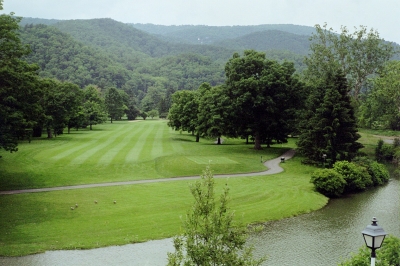 |
| At 449 yards (par four), the 1st hole is Old White's #1 handicap hole. The tee is literally right near the Golf Club -- something you'll always remember. |
It was great, indeed, having hosted many names from golf’s ‘who’s who’ in its glory days, from Byron Nelson to Gary Player to Arnold Palmer to Lloyd Mangrum. Not to mention the Greenbrier’s Head Golf Professional of that era, Sam Snead – Old White was always Snead’s favorite golf course at The Greenbrier.
With such a distinguished past, then how is the best yet to come?
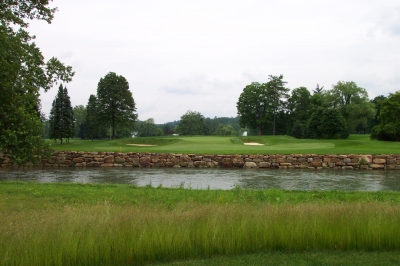 |
| Fesuce grasses growing in on the newly finished 15th hole, called 'Eden.' It's just a hint at what the 'new' Old White will look like. |
It’s because work is just getting started to restore Old White to its former glory. What continues to be a fine test of golf has changed significantly in its 90+ years in existence, and much of what once made it extra special has morphed into non-playability (at least on the greens), or just plain run-of-the-mill ordinariness. How’s that for a change for the worse.
Don’t get me wrong – it’s still a pleasure to play on Old White… but one can only wonder what it was like during the golden times, when the course really shined brightly.
Robert Harris, The Greenbrier’s Director of Golf, tells a bit of the Old White story: “It was a lot different building a golf course back in the early 1900’s, because you really couldn’t move much dirt or clear a lot of trees. So MacDonald took our prime farmland, which was relatively flat for this part of the country (formerly used to grow corn and wheat), and built the course to conform to the land.”
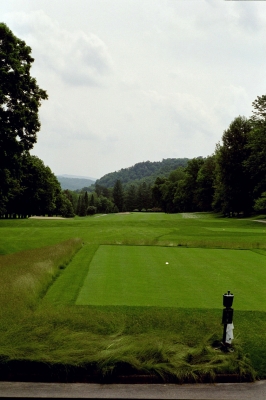 |
| The 465-yard 6th hole is playing temporarily as a par five, and the tees have been re-done. When it moves back to a par four, watch out for this one. |
“He did quite the masterful job, too,” Harris continued. “We’ve had several architects up here looking at the land and they pointed out how the course follows the mountain tops, which are all forested now. MacDonald laid out the course with what he saw in the background, which is the way Tom Fazio did with the new ‘The Snead’ course. You won’t necessarily notice it when playing a round, but it helps the golf blend into the environment. But a lot of that ‘subliminal’ quality of Old White is hidden now because of the trees on the golf course.”
Harris’s last remark hints at Old White’s biggest change in those nine decades. What was once completely open (with maybe a tree here and there) is now heavily populated with tall trees. The holes were originally defined by cut grass, but now you’re playing down dense alleyways of deciduous spectators.
The trees in The Greenbrier setting just seem to belong there, yet they’re detracting from the character and strategy of the golf course. And while some of them will be taken out, fully returning the course to its ‘open’ days isn’t practical, or even logical.
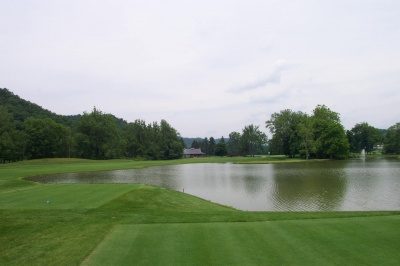 |
| The par four 16th hole has been re-named 'Cape.' The tee shot's easier than it looks, but you will have to aim for the correct spot on the dogleg to avoid going too long. |
“A lot of people have been coming to The Greenbrier for decades,” Harris said. “And many of those people say Old White is their favorite golf course, which includes the trees. So we’re going about removing the trees that will restore the course to its original condition from a strategy standpoint, and also help us maintain it to the standards which Greenbrier guests expect – especially the greens.”
That’s where George comes in. Several greens on the golf course have been altered so considerably from their original surface-drained shaping that they no longer function – either from a drainage or playability capacity. Old White’s first green to undergo a metamorphosis was #9 (named ‘Punchbowl’), because bunker sand and the steady growth of trees around it (which blocked out sunlight and stifled air circulation) had virtually destroyed it. Now, thanks to George, it’s back.
But how do you restore an entire golf course that was built nearly a century ago to its original glory, without the aid of modern high-tech drawings or even detailed yardage books from when it was first constructed? Time, constant play and vegetation have changed it into something that looks nothing like it did all those years before. And it’s not like there’s anyone alive who can testify as to what was there… and why.
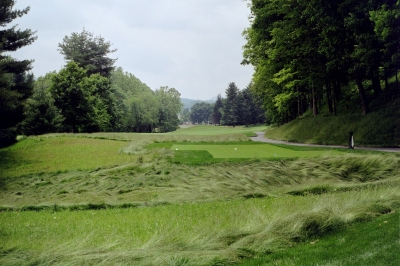 |
| Looking from the tee of the par four 13th hole -- wispy fescues and big trees. A little bit of the old, a little bit of the new. |
George provides the answers: “When the Greenbrier folks contacted us about renovating Old White, we talked with the resort’s historian (Bob Conte) and got some old aerial photos of the golf course and blew them up to wall size. From those, we spent four or five months studying them, focusing on lengths of shadows, contours that we could see, creeks that were there back then. We tried to determine why certain holes once contained things that weren’t apparent anymore – basically, tried to find out what it looked like when it was built.”
Even the photos only date to the 20’s, after Seth Raynor had already come in to ‘soften’ Old White because it was too difficult for the resort’s guests. So some of the original MacDonald design (the part changed by Raynor) is lost to history – but a good portion of it is coming back, circa 2006 (when the restoration will be completed).
George says they could tell the ‘old’ course was more difficult than its contemporary version – especially in the number and severity of the ‘old’ bunkers – but the biggest departure in the modern golf layout was course strategy. Time had robbed the course of some of its protection in the form of bunkers, grassy mounds and streams, and that’s what the restoration’s bent on putting back. Some folks are upset that anyone would dare ‘tinker’ with Old White, but George insists the final product will satisfy everyone, and make the course a much better and interesting place to play.
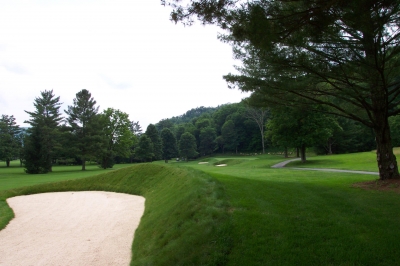 |
| George has already re-done the fairway bunkers on the 412-yard, par four 9th hole. If you're in one of them, you're probably going to have to get up and down for par. |
The work done thus far includes installing drainage to the course, something that was desperately needed. The layout is bordered by mountains on one side, and George said when it rained, all that water would come bounding down with little alternative than to spread out all across the valley below – which made for a pretty soggy Old White Course.
Aside from the necessary strategic and practical alterations to Old White, Harris said there were other reasons why the course had to move with the times – which oddly enough, are social and demographic in nature: “Over the last ten years, a lot more people are ‘using’ the Old White course. In the early 90’s, we’d have maybe sixty to a hundred children at The Greenbrier at any one time. Now, people travel with their kids, and we’ll typically have three to four hundred young people on property. And those children (and their parents) are using the paths that come through the golf course.”
Not the cart paths, mind you. There’s the Valley View Trail that travels at a safe distance from the fairways, yet still can come face-to-face with shanked missiles from unskilled players with no malevolent intentions to hurt someone.
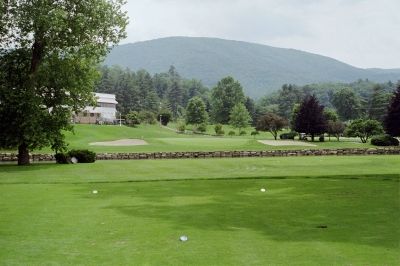 |
| The green of Old White's par three 18th is right in front of the clubhouse -- and you'll have to hit over the river to reach it. Not a difficult carry, but something to think about on the last hole of the day. |
Harris says they’ve re-worked the roadways to where they won’t impact the golf course as much – and now you’ll have to hit it very bad to bring the biking youngsters and horse-drawn carriage riders into play. They’ve also added a new bridge just upstream from the golf bridge on the first hole, to allow safer access to the trail for bikers and walkers. It’s all part of the ‘new’ Old White course.
In addition to the strategy and practical elements, George, Harris and the designers are bringing a different ‘look’ to Old White, in the form of fescue grasses that help define the playing areas. When we visited they were just growing in on a few holes, but when the project’s complete, Old White will have a bold ‘new’ look – which ironically, is designed to make it ‘feel’ like the original version.
“Because the golf course was essentially built in a field, they had those wispy grasses in the areas in between holes. You could basically see the entire golf course from one end to the other in those days, so long and short grass is what you’d see,” George explained.
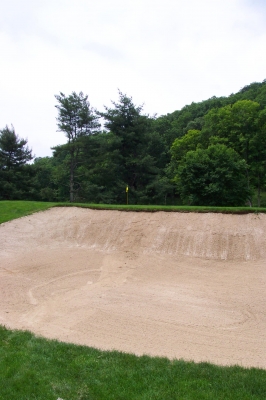 |
| Greenside at the par five 12th hole. This bunker is large and deep. Some advice: don't go left on the approach. |
“That long grass was the only thing defending the holes, keeping people from cutting off corners and going across doglegs – hitting it in that long grass was a real penalty, like we saw at Shinnecock this year,” George added.
“For our purposes, the long grass isn’t necessarily penal – it’s more to give the golf course a look and ‘feel’ like the original. Because it’s a resort golf course, we want people to be able to potentially find and play a ball that goes into the tall stuff, not experience the frustration of having to look for golf balls all the time and slow up play,” George said.
Harris said when it’s all done, there’ll be 15 to 20 acres of the fescue grass, and that certainly will give the course a different look. For now, it’s most prominent on Old White’s newest holes, primarily thirteen, fourteen, fifteen and sixteen.
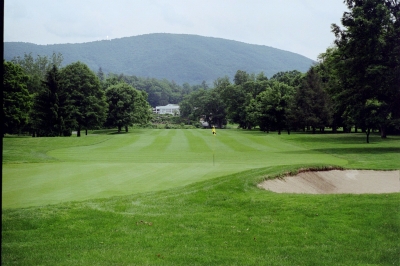 |
| From in back of the 1st green, you can see the clubhouse on top of the slope. It's a grand sight, and you've just started the course. |
A final unique aspect of Old White’s restoration is a throwback to its original architects’ preference to ‘copy’ old world golf holes – they’d taken famous links from courses overseas, and put them on their new world creations. Take Old White’s #12 for example, which was originally reminiscent of the 14th hole at St. Andrews, called ‘Long.’ It’s a par five, and though it didn’t originally have a ‘hell’ bunker like its famous namesake, it played like it – with trouble in the second shot landing area which basically forced you to go over it, or to the side, where you won’t have nearly as good a shot into the green.
In a nutshell, that’s what George has set out to do – restore the original demand for precise shot-making.
Aiding in that effort are some long-term living testimonials. Harris elaborates: “Before we began this process, we took a couple gentlemen out on the course who’d known it for decades – a course foreman who’d been here for over 50 years, and John Murphy, the previous Head Golf Professional. On those occasions, their memories started coming back about how things had been altered over time – and almost every hole had changed significantly over those years.”
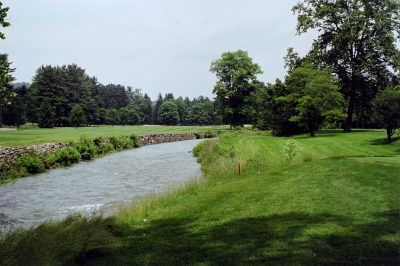 |
| You can't see it here, but the Greenbrier's 'Valley View Trail' is to the left of the par five 17th hole. It's easy to see why someone other than golfers would want to share in the beauty. |
Together, with personal recollections and photos and old documents -- the pieces of the Old White puzzle are falling into place, and George and Harris are taking careful aim to put the picture together in a way that will please the traditionalists and more modern resort golfers. The work will continue until the spring of 2006, when the ‘new’ Old White will be introduced.
But it won’t really be ‘new,’ and that’s a good thing. In that sense, the best truly is yet to come.
Note: See links below for complete reviews of The Greenbrier Resort and its golf courses.
Details:
The Old White at The Greenbrier
Phone: (800) 453-4858; FAX: (304) 536-7872
Website: www.greenbrier.com
Course Designers: Charles Blair MacDonald, Seth Raynor and Lester George
Director of Golf: Robert Harris
Head Golf Professional: Hill Herrick, Jr.
Tees/Yardage/Slope/Rating
Gold 6499 129/71.8
Blue 6144 123/69.6
White 5787 123/68.4 124/73.3 (L)
Red 4878 114/68.3 (L)
Rates
$180 per day for all three Greenbrier Resort courses, includes golf cart. Replays available for an additional $35 for cart fee. Greens fee is good for the whole day, on all courses.
Walking is allowed anytime, with a $35 credit for the golf cart.
Caddies are available. No pull carts.
Fees include unlimited range privileges, all day after paying fee.
Several packages available including golf, meals and accommodations at The Greenbrier. Consult the website for more information.
| Related Links | Comments on this article? | |
|
Maryland National Golf Club Hollow Creek Golf Club Rocky Gap Resort PB Dye Golf Club in Ijamsville Whiskey Creek Golf Club |
E-mail Jeff Rendall, Editor: jrendall@golftheunitedstates.com |












